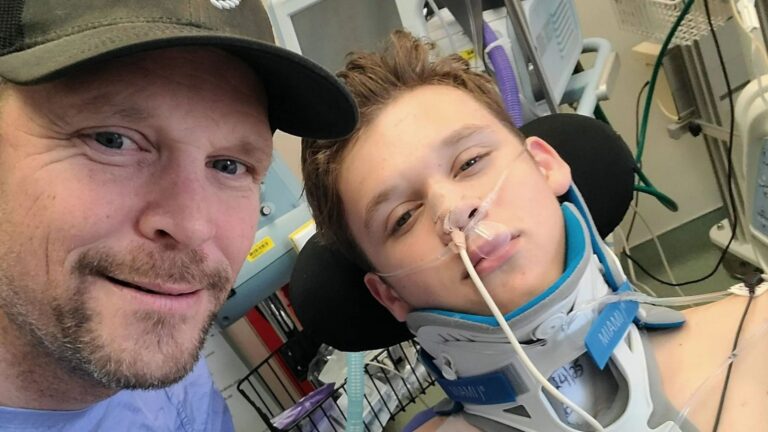A SPORTY teen has been left paralysed from the chest down after landing on his neck – doing a trampoline somersault ‘he’d done a million times before’.
David Sample was performing the mid-air stunt while playing in the garden on April 23rd but didn’t manage to flip over completely, meaning he landed awkwardly.

5

5

5
The 16-year-old shouted for help, telling horrified family members he couldn’t feel his body from the chest down and feared he’d broken his neck.
Medics carefully moved the lad into an ambulance and life-flighted him to Harborview Medical Center in Seattle, Washington, where a CAT scan revealed a fracture in his neck.
Despite undergoing a gruelling 12-hour surgery to ‘strengthen’ his neck, the student was given the devastating news that he’s unlikely to walk again.
David’s family, including 41-year-old dad Ray Sample, are now at his bedside and remain hopeful that he’ll regain some movement.
But now facing huge medical expenses and ongoing care and treatment, the family are appealing for help on GoFundMe as the adjust to David’s life-changing injury.
Ray, from Richland, Washington, US, said: “He jumped on trampolines for many years, he’s been jumping ever since he was a kid.
“He was doing a trick he’s done a million times before, he just didn’t go all the way over and landed on his neck.
“My ex-wife and her husband were there and David called out when it happened and said, ‘I think I just broke my neck’.
“He was paralysed from the chest down and couldn’t move his legs.
“The first responders had to cut the trampoline net to put him on the stretcher without moving him [his neck].
“I was shocked. How can you feel after that, how can you process it? It’s impossible to put into words.
“It’s heartbreaking.”
Artist Ray said David, who loved rock-climbing, backpacking and basketball, is still hopeful he’ll be able to be an adrenaline junkie from his wheelchair.
Ray said: “My first thought was ‘it can’t be my son’.
“If anything, he is the one who would have something like this happen in one of his crazy adventures.
“He’s a rock climber, he goes out and plays basketball, he loves heights and backpacking and going on tons of crazy adventures.
He keeps saying ‘why did I do this?’ It was a complete accident
David Sample
“This happened on the trampoline? That’s insane.
“He’s already asked me ‘would they let me parachute out of an airplane in a wheelchair?’
“The goal is to remain absolutely positive, we’ve attempted to keep him full of hope.
“He’s dealing with depression as it starts to sink in that this is his life right now and we don’t know if it will ever be the same again.
“We’re saying ‘this is what they’re saying right now, but it’s not hopeless’.
“He keeps saying ‘why did I do this?’ It was a complete accident. It’s not something he was trying to do.

5

5
“He has an amazing personality, he loves to be the centre of attention but in a goofy way. In a way where if he can make you laugh he is happy.
“This has been devastating for all of us.”
To donate, visit the family’s GoFundMe page here.
Garden trampoline safety
GARDEN trampolines can be fun, but they do carry a risk of injury, particularly for younger children.
The Royal Society for the Prevention of Accidents (RoSPA) estimates that 13,000 people are injured on trampolines each year in England.
To make trampolines safer, it’s crucial to follow specific guidelines and ensure proper supervision.
Key safety points
- Trampolining isn’t suitable for children under the age of six because they’re not sufficiently physically developed to control their bouncing.
- Trampolining injuries can occur to all parts of the body, including the neck, arms, legs face and head. Head and neck injuries are the most serious injuries associated with trampolines. The most common injuries are caused by awkward landings and include sprains or fractures to the wrist, forearm, elbow and collarbone.
- Adult supervision is no guarantee of safety. More than half of all trampoline accidents occur whilst under supervision. However a trained ‘spotter’ can greatly reduce this risk.
- Never combine alcohol with trampolining! Children have been hurt while bouncing with adults who have been drinking at summer garden parties.
- Whatever your ability level, join a local trampolining club to learn new trampolining skills, ranging from the basics of landing safely to advanced moves such as somersaults.
Before you buy
- Choose a model with safety pads, and check that the pads cover the springs, hooks and frame. The colour of the pads should contrast with the frame.
- Consider models with safety netting as part of the design, or buy this at the same time. The safety netting should prevent the bouncers from hitting rigid component like springs or the frame. They should also prevent bouncing off the trampoline.
- New trampolines should meet the European Standard EN71-14:2014 ‘Safety of toys – Trampolines for domestic use’.
Where to put it
- Ideally, place the trampoline on energy absorbing ground, such as a soft and springy lawn, or bark wood chip, sand or other cushioning material.
- If you do not have a net, look to have a safe zone of 2.5metres, clear of toys etc on the ground and objects such as trees, washing lines, poles, glass frames and other hard items. Never place the trampoline on hard surfaces such as concrete, tarmac or hard packed mud without absorbent safety matting.
Checking and keeping it safe
- Ensure trampolines are tied down before use.
- Be sure to check the padding and nets are in place and that the spring and fixed-metal parts are covered.
- On windy days and during the winter, it can be best to pack down the trampoline.
- Some trampolines have ladders. Where possible remove them to limit unsupervised access by smaller children, when the trampoline is not in use.
Source: The Royal Society for the Prevention of Accidents


